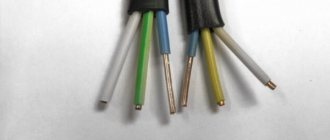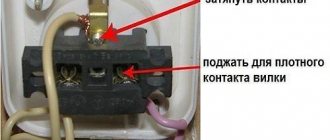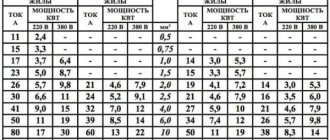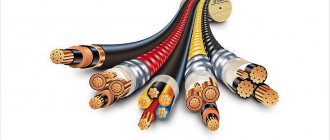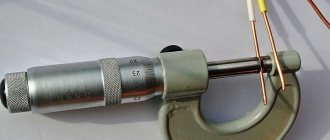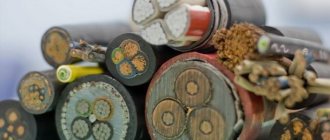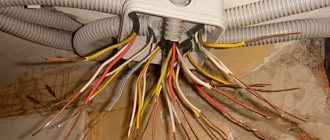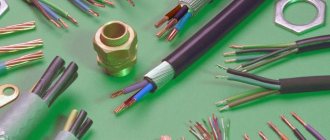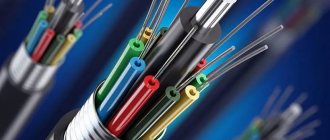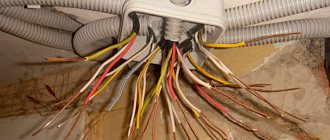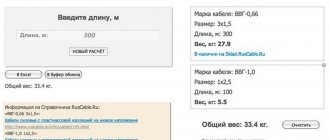PUE and GOST tables
Regulations:
- Rules for electrical installations (6th, 7th edition) read
- Read the rules for technical operation of power plants and networks of the Russian Federation
- GOST 839-80 Non-insulated wires for overhead power lines. Technical specifications (with Amendments No. 1, 2) read
- STO 56947007-29.240.55.143-2013 “Methodology for calculating maximum current loads under the conditions of maintaining the mechanical strength of wires and permissible dimensions of overhead lines. Organization standard of PJSC FGC UES read
- MT 34-70-037-87 (RD 34.20.547, SO 153-34.20.547) “Methodology for calculating maximum current loads according to wire heating conditions for existing power lines” read
- Order of the Ministry of Energy of the Russian Federation dated July 23, 2012 N 340 “On approval of the list of information provided by electric power industry entities, forms and procedure for its provision” read
Best regards, Elensis.ru
Current Density
When choosing a wire cross-section, you need to know some indicators. So, for example, the current density in a material such as copper ranges from 6 to 10 A/mm2. This indicator is the result of many years of experience by specialists and is adopted based on the basic rules governing the design of electrical installations.
In the first case, with a density of six units, the electrical network is provided for long-term operation. If the indicator is ten units, then it should be understood that network operation is not possible for a long time during periodic short turns on.
Therefore, it is necessary to select the thickness precisely according to this permissible indicator.
The above data is for copper cable. Aluminum wires are still used in many electrical networks. At the same time, copper cable has its undeniable advantages in comparison with the latter type of wire.
These include the following:
- Copper cable has much greater softness and at the same time its strength is higher.
- Products made from copper are not subject to oxidation processes for a longer period of time.
- Perhaps the most important indicator of a copper cable is its higher degree of conductivity, and therefore a better indicator of current density and power.
The most important disadvantage of such a cable is its higher price.
The current density indicator for aluminum wire is in the range from four to six A/mm2. Therefore, it can be used in less critical structures. This type of wiring was also actively used in the last century in the construction of residential buildings.
Permissible continuous heating power of a three-core cable with a voltage of 6-10 kV
Table 3.39
| Section, mm2 | 6 kV | 10 kV | ||
| Air | Earth | Air | Earth | |
| 10 | 0,7/0,5 | 0,8/0,6 | — | — |
| 16 | 1,0/0,7 | 1,0/0,8 | 1,5/1,1 | 1,5/1,2 |
| 25 | 1,3/0,9 | 1,3/1,0 | 1,9/1,4 | 2,0/1,5 |
| 35 | 1,6/1,2 | 1,6/1,2 | 2,3/1,7 | 2.4/1,8 |
| 50 | 2,0/1,5 | 1,9/1,5 | 2,8/2,2 | 2,9/2,2 |
| 70 | 2,4/1,8 | 2,3/1,8 | 3,6/2,7 | 3,5/2,7 |
| 95 | 2,9/2,2 | 2,7/2,1 | 4,3/3,3 | 4,1/3,1 |
| 120 | 3,4/2,5 | 3,1/2,4 | 5,0/3,8 | 4,7/3,6 |
| 150 | 3,8/2,9 | 3,5/2,7 | 5,7/4,3 | 5,2/4,0 |
| 185 | 4,3/3,3 | 3,9/3,0 | 6,4/4,9 | 5,8/4,5 |
| 240 | 5,0/3,8 | 4,4/3,4 | 6,5/5,3 | 6,5/5,1 |
Notes.
- The numerator contains data for cables with copper conductors, the denominator - with aluminum conductors.
- Power for cables laid in water is determined by multiplying the indicators in the table. 3.39 by a factor of 1.3.
- For cables manufactured before 1984 inclusive, power values should be multiplied by the following factors: 6 kV, installation in the ground - 0.855: installation in the air - 0.82; 10 kV, laying in the ground - 0.92; laying in the air - 0.91.
- Permissible continuous power is given for U— 1.05 U, cos = 0.9.
Carrying out current cross-section calculations
When calculating the working indicator of cable thickness, it is necessary to know what current will flow through the network of a given room. For example, in the most ordinary apartment it is necessary to sum up the power of all electrical appliances that are connected to the network.
As an example for calculation, we can give a standard table of power consumption by the main household appliances used in an ordinary apartment.
Based on the total power, the current that will flow through the network cables is calculated.
I=(P*K1)/U
In this formula, P means the total power, measured in Watts, K1 is the coefficient that determines the simultaneous operation of all household appliances (its value is usually 0.75) and U is the voltage in the home network, usually equal to 220 Volts.
This current calculation indicator will help to estimate the required cross-section for the general network. In this case, it is also necessary to take into account the operating current density.
This calculation can be taken as an approximate choice. In this case, more accurate indicators can be obtained using a selection from a special PUE table. This PUE table is an element of special rules for the design of electrical installations.
Below is an example of a PUE table that can be used to select a section.
As you can see, such a PUE table, in addition to the dependence of cross-sections on the current indicator, also provides for taking into account the material from which the wires are made, as well as its location. In addition, the table regulates the number of cores and the voltage value, which can be either 220 or 380 Volts.
Review of manufacturers
From the city of Elektrougli, it produces products for various purposes, including power cables of the VVG type. Founded in 2000, the production allows us to produce products of excellent quality at the most modern level. The main direction is power, non-flammable cables with insulation and an outer sheath made of polymer composites, designed for voltages of 0.66 and 1 kV.
Price for VVG cables:
- brand 2x1.5(P) – 11.24 rubles;
- brand 2x2.5 (P) – 18.44 rubles;
- brand 2x4.0(P) – 28.72 rubles;
- brand 2x6.0 – 41.97 rubles;
CJSC Cable
Since 2004, it has continued the traditions of the Kavkazkabel trademark, which has been producing products since 1958. The main product samples are wires and power cables for various areas of use - power, ships, for pumps and alarms.
Production Association LLC "Rybinskkabel"
City of Rybinsk. Since the founding of the plant in 1949, it has been producing the entire range of cable products and wires for the electrical industry. But the main direction is wires for various electrical machines and devices. It is worth noting that this company represents the largest range of VVG brand products, both in names and dimensional lengths.
Prices for three-core conductors:
- 3x1.5 (P/cr) – 16.76-16.97 rubles;
- 3x2.5 (P/kr) – 27.57-28.02 rubles;
- 3x4.0 (P/kr) – 42.82-43.56 rubles;
- 3x6.0 (P/kr) – 62.70-63.92 rubles;
JSC "PODOLSKKABEL"
Leader of cable industry enterprises in the Moscow region. The plant ranks first among mechanical engineering enterprises in the Moscow region. “Podolskkabel” is an enterprise that is dynamically developing its production based on the introduction of new high-tech production facilities.
Four-core wires are sold at prices:
- 4x1.5 – 22.34 rubles;
- 4x2.5 – 37.05 rub;
- 4x4.0 – 58.26 rubles;
- 4x6.0 – 85.41 rub;
- 4x6.0 – 85.41 rub;
- 4x10.0 – 159.03 rub;
- 4x16.0 – 255.43 rubles;
"Amur Cable Plant"
This is the only plant producing cable and wire products in the Far East , the main direction is the production of high-tech power cables for various industries both in Russia and abroad. In total, the plant has about 8,000 macro-sizes in its arsenal, and all manufactured goods are certified both for the domestic market and for supplies abroad.
VVG stranded wires in 5-core version:
- 5x1.5 – 27.75 rubles;
- 5x2.5 – 47.39 rubles;
- 5x4.0 – 72.40 rubles;
- 5x6.0 – 106.27 rubles;
- 5x10.0 – 198.94 rubles;
- VVG 5x16.0 – 318.10 rubles;
Current calculation using additional parameters
When calculating the cross section based on current using the PUE table, you can also use additional parameters.
For example, it is possible to take into account the core diameter. Therefore, when determining the cross-section of the conductor, special equipment called a micrometer is used. Based on its data, the thickness of each core is determined. Then, using the values of previously obtained currents and a special table, the final selection of the cross-sectional value of the wire core is made.
If the cable consists of several cores, then you should measure one of them and calculate its cross-section. After this, to find the final thickness value, the indicator obtained for one core is multiplied by their number in the wire.
The value of the cable cross-section obtained in this way using calculations and the PUE table will allow you to create wiring in a house or apartment that will serve the owners for quite a long period of time without the occurrence of emergency or emergency situations.
Continuous-permissible current loads for bare wires
Permissible long-term current loads ( DDTN ) for bare wires made in accordance with GOST 839-80 are presented on the basis of table. 1.3.29 PUE (adopted based on the permissible heating temperature of +70 °C at an air temperature of +25 °C, based on clause 1.3.22 of the PUE).
DDTN for wires AC, ASKS, ASK, ASKP at tcore=+70 C and tmedium=+25 C
| Section (aluminium/steel), mm2 | Current, A, for wire brands | |
| AC, ACCC, ASK, ASKP | ||
| outdoors | indoors | |
| 10/1,8 | 84 | 53 |
| 16/2,7 | 111 | 79 |
| 25/4,2 | 142 | 109 |
| 35/6,2 | 175 | 135 |
| 50/8 | 210 | 165 |
| 70/11 | 265 | 210 |
| 95/16 | 330 | 260 |
| 120/19 | 390 | 313 |
| 120/27 | 375 | — |
| 150/19 | 450 | 365 |
| 150/24 | 450 | 365 |
| 150/34 | 450 | — |
| 185/24 | 520 | 430 |
| 185/29 | 510 | 425 |
| 185/43 | 515 | — |
| 240/32 | 605 | 505 |
| 240/39 | 610 | 505 |
| 240/56 | 610 | — |
| 300/39 | 710 | 600 |
| 300/48 | 690 | 585 |
| 300/66 | 680 | — |
| 330/27 | 730 | — |
| 400/22 | 830 | 713 |
| 400/51 | 825 | 705 |
| 400/64 | 860 | — |
| 500/27 | 960 | 830 |
| 500/64 | 945 | 815 |
| 600/72 | 1050 | 920 |
| 700/86 | 1180 | 1040 |
[collapse]
For other ambient temperatures, the current values are presented taking into account correction factors from Table 1.3.3 of the Electrical Installation Regulations.
DDTN for wires AC, ASKS, ASK, ASKP at tcore=+70 C and tenvironment from -5 and below to +50 C
from - 5 to +10 0С
.
| Sech. (al/st), mm2 | DDTN of wires AC, ASKS, ASK, ASKP for ambient temperatures from -5 and below to +10 (hybrid of tables 1.3.3 and 1.3.29) | |||
| -5 and below | 0 | +5 | +10 | |
| 10/1,8 | 108,36 | 104,16 | 100,8 | 96,6 |
| 16/2,7 | 143,19 | 137,64 | 133,2 | 127,65 |
| 25/4,2 | 183,18 | 176,08 | 170,4 | 163,3 |
| 35/6,2 | 225,75 | 217 | 210 | 201,25 |
| 50/8 | 270,9 | 260,4 | 252 | 241,5 |
| 70/11 | 341,85 | 328,6 | 318 | 304,75 |
| 95/16 | 425,7 | 409,2 | 396 | 379,5 |
| 120/19 | 503,1 | 483,6 | 468 | 448,5 |
| 120/27 | 483,75 | 465 | 450 | 431,25 |
| 150/19 | 580,5 | 558 | 540 | 517,5 |
| 150/24 | 580,5 | 558 | 540 | 517,5 |
| 150/34 | 580,5 | 558 | 540 | 517,5 |
| 185/24 | 670,8 | 644,8 | 624 | 598 |
| 185/29 | 657,9 | 632,4 | 612 | 586,5 |
| 185/43 | 664,35 | 638,6 | 618 | 592,25 |
| 240/32 | 780,45 | 750,2 | 726 | 695,75 |
| 240/39 | 786,9 | 756,4 | 732 | 701,5 |
| 240/56 | 786,9 | 756,4 | 732 | 701,5 |
| 300/39 | 915,9 | 880,4 | 852 | 816,5 |
| 300/48 | 890,1 | 855,6 | 828 | 793,5 |
| 300/66 | 877,2 | 843,2 | 816 | 782 |
| 330/27 | 941,7 | 905,2 | 876 | 839,5 |
| 400/22 | 1070,7 | 1029,2 | 996 | 954,5 |
| 400/51 | 1064,25 | 1023 | 990 | 948,75 |
| 400/64 | 1109,4 | 1066,4 | 1032 | 989 |
| 500/27 | 1238,4 | 1190,4 | 1152 | 1104 |
| 500/64 | 1219,05 | 1171,8 | 1134 | 1086,75 |
| 600/72 | 1354,5 | 1302 | 1260 | 1207,5 |
| 700/86 | 1522,2 | 1463,2 | 1416 | 1357 |
from +15 to +30 0С
| Sech. (al/st), mm2 | DDTN of wires AC, ASKS, ASK, ASKP for ambient temperature from +15 to +30 (hybrid of tables 1.3.3 and 1.3.29) | |||
| +15 | +20 | +25 | +30 | |
| 10/1,8 | 93,24 | 88,2 | 84 | 78,96 |
| 16/2,7 | 123,21 | 116,55 | 111 | 104,34 |
| 25/4,2 | 157,62 | 149,1 | 142 | 133,48 |
| 35/6,2 | 194,25 | 183,75 | 175 | 164,5 |
| 50/8 | 233,1 | 220,5 | 210 | 197,4 |
| 70/11 | 294,15 | 278,25 | 265 | 249,1 |
| 95/16 | 366,3 | 346,5 | 330 | 310,2 |
| 120/19 | 432,9 | 409,5 | 390 | 366,6 |
| 120/27 | 416,25 | 393,75 | 375 | 352,5 |
| 150/19 | 499,5 | 472,5 | 450 | 423 |
| 150/24 | 499,5 | 472,5 | 450 | 423 |
| 150/34 | 499,5 | 472,5 | 450 | 423 |
| 185/24 | 577,2 | 546 | 520 | 488,8 |
| 185/29 | 566,1 | 535,5 | 510 | 479,4 |
| 185/43 | 571,65 | 540,75 | 515 | 484,1 |
| 240/32 | 671,55 | 635,25 | 605 | 568,7 |
| 240/39 | 677,1 | 640,5 | 610 | 573,4 |
| 240/56 | 677,1 | 640,5 | 610 | 573,4 |
| 300/39 | 788,1 | 745,5 | 710 | 667,4 |
| 300/48 | 765,9 | 724,5 | 690 | 648,6 |
| 300/66 | 754,8 | 714 | 680 | 639,2 |
| 330/27 | 810,3 | 766,5 | 730 | 686,2 |
| 400/22 | 921,3 | 871,5 | 830 | 780,2 |
| 400/51 | 915,75 | 866,25 | 825 | 775,5 |
| 400/64 | 954,6 | 903 | 860 | 808,4 |
| 500/27 | 1065,6 | 1008 | 960 | 902,4 |
| 500/64 | 1048,95 | 992,25 | 945 | 888,3 |
| 600/72 | 1165,5 | 1102,5 | 1050 | 987 |
| 700/86 | 1309,8 | 1239 | 1180 | 1109,2 |
* highlighted values correspond to those indicated in table 1.3.29 PUE
from +35 to +50 0С
| Sech. (al/st), mm2 | DDTN of wires AC, ASKS, ASK, ASKP for ambient temperature from +35 to +50 (hybrid of tables 1.3.3 and 1.3.29) | |||
| 35 | 40 | 45 | 50 | |
| 10/1,8 | 73,92 | 68,04 | 62,16 | 56,28 |
| 16/2,7 | 97,68 | 89,91 | 82,14 | 74,37 |
| 25/4,2 | 124,96 | 115,02 | 105,08 | 95,14 |
| 35/6,2 | 154 | 141,75 | 129,5 | 117,25 |
| 50/8 | 184,8 | 170,1 | 155,4 | 140,7 |
| 70/11 | 233,2 | 214,65 | 196,1 | 177,55 |
| 95/16 | 290,4 | 267,3 | 244,2 | 221,1 |
| 120/19 | 343,2 | 315,9 | 288,6 | 261,3 |
| 120/27 | 330 | 303,75 | 277,5 | 251,25 |
| 150/19 | 396 | 364,5 | 333 | 301,5 |
| 150/24 | 396 | 364,5 | 333 | 301,5 |
| 150/34 | 396 | 364,5 | 333 | 301,5 |
| 185/24 | 457,6 | 421,2 | 384,8 | 348,4 |
| 185/29 | 448,8 | 413,1 | 377,4 | 341,7 |
| 185/43 | 453,2 | 417,15 | 381,1 | 345,05 |
| 240/32 | 532,4 | 490,05 | 447,7 | 405,35 |
| 240/39 | 536,8 | 494,1 | 451,4 | 408,7 |
| 240/56 | 536,8 | 494,1 | 451,4 | 408,7 |
| 300/39 | 624,8 | 575,1 | 525,4 | 475,7 |
| 300/48 | 607,2 | 558,9 | 510,6 | 462,3 |
| 300/66 | 598,4 | 550,8 | 503,2 | 455,6 |
| 330/27 | 642,4 | 591,3 | 540,2 | 489,1 |
| 400/22 | 730,4 | 672,3 | 614,2 | 556,1 |
| 400/51 | 726 | 668,25 | 610,5 | 552,75 |
| 400/64 | 756,8 | 696,6 | 636,4 | 576,2 |
| 500/27 | 844,8 | 777,6 | 710,4 | 643,2 |
| 500/64 | 831,6 | 765,45 | 699,3 | 633,15 |
| 600/72 | 924 | 850,5 | 777 | 703,5 |
| 700/86 | 1038,4 | 955,8 | 873,2 | 790,6 |
[collapse]
DDTN for PA hollow wires at tcore=+70 and tenvironment from -5 and below to +50 C
.
from -5 to +10 0С
| Wire type | Correction factors for currents at the design temperature of the environment | |||
| -5 and below | 0 | 5 | 10 | |
| PA500 | 1728,6 | 1661,6 | 1608 | 1541 |
| PA600 | 2167,2 | 2083,2 | 2016 | 1932 |
from +15 to +30 0С
| Wire type | Correction factors for currents at the design temperature of the environment | |||
| 15 | 20 | 25 | 30 | |
| PA500 | 1487,4 | 1407 | 1340 | 1259,6 |
| PA600 | 1864,8 | 1764 | 1680 | 1579,2 |
from +35 to +50 0С
| Wire type | Correction factors for currents at the design temperature of the environment | |||
| 35 | 40 | 45 | 50 | |
| PA500 | 1179,2 | 1085,4 | 991,6 | 897,8 |
| PA600 | 1478,4 | 1360,8 | 1243,2 | 1125,6 |
[collapse]
Correction factors for currents for bare wires depending on the ambient temperature
Fragment of table 1.3.3 PUE (beginning)
| tс °С | tj °C | Correction factors for currents at the design temperature of the environment | |||||
| -5 and below | 0 | +5 | +10 | +15 | +20 | ||
| 15 | 80 | 1,14 | 1,11 | 1,08 | 1,04 | 1,00 | 0,96 |
| 25 | 80 | 1,24 | 1,20 | 1,17 | 1,13 | 1,09 | 1,04 |
| 25 | 70 | 1,29 | 1,24 | 1,20 | 1,15 | 1,11 | 1,05 |
Notes: * tс - conditional temperature of the environment, °C; ** tl — normalized core temperature, °C;
*** The highlighted line has tmediums and tcores corresponding to Table 1.3.29.
.
.
Fragment of Table 1.3.3 PUE (end)
| tс °С | tj °C | Correction factors for currents at the design temperature of the environment | |||||
| +25 | +30 | +35 | +40 | +45 | +50 | ||
| 15 | 80 | 0,92 | 0,88 | 0,83 | 0,78 | 0,73 | 0,68 |
| 25 | 80 | 1,00 | 0,95 | 0,90 | 0,85 | 0,80 | 0,74 |
| 25 | 70 | 1,00 | 0,94 | 0,88 | 0,81 | 0,74 | 0,67 |
Notes: * tс - conditional temperature of the environment, °C; ** tl — normalized core temperature, °C;
*** the highlighted line has tmediums and tcores corresponding to table 1.3.29
[collapse]
Which cable is better to buy?
Following the strict recommendations of the PUE, for the arrangement of personal property we will buy cable products with the “letter groups” NYM and VVG in the marking. They are the ones who do not cause any complaints or quibbles from electricians and firefighters. Option NYM is an analogue of domestic VVG products.
It is best if the domestic cable is accompanied by the NG index, this means that the wiring will be fire resistant. If you intend to lay the line behind a partition, between joists or above a suspended ceiling, buy products with low smoke emission. They will have the LS index.
This is a simple way to calculate the cross-section of the cable conductor. Information about the principles of calculations will help you rationally select this important element of the electrical network. The necessary and sufficient size of the current-carrying core will provide power to home appliances and will not cause a fire in the wiring.
